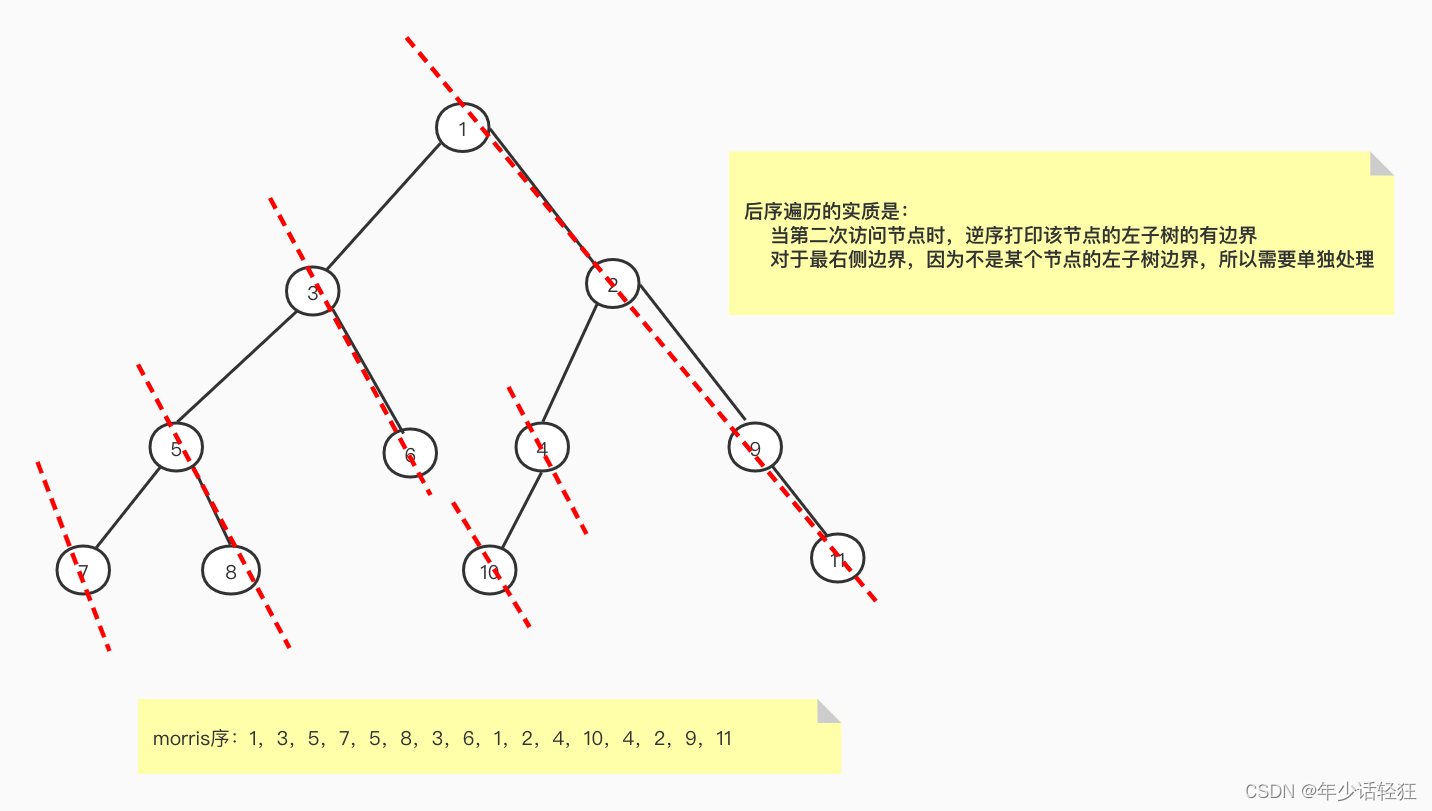在刷leetcode上二叉树相关题目时144题,看到了一种morris的实现方式,可以把实现的空间复杂度降低到O(1),解法研究半天也是一头雾水,网上找资料和视频详细学了一下。
题目:
递归解法
对于前中后序遍历,常规的递归解题套路:
public void preOrder(List<Integer> res, TreeNode root) {
if (root == null) return;
res.add(root.val);//前序
preOrder(res, root.left);
res.add(root.val);//中序
preOrder(res, root.right);
res.add(root.val);//后序
}对于递归解法来说,会使用一个树身高度的额外空间存储从根节点到叶子节点的元素,用于回溯的时候找到父节点,所以时间复杂度和空间复杂度均为O(n)
morris算法实现
有一种巧妙的方法可以在线性时间内,只占用常数空间来实现前序遍历。这种方法由 J. H. Morris 在 1979 年的论文「Traversing Binary Trees Simply and Cheaply」中首次提出,因此被称为 Morris 遍历。
左神的讲解就通俗易懂了,学习地址:左神讲解morris遍历
Morris 遍历的核心思想是利用树的大量空闲指针,实现空间开销的极限缩减。其规则总结如下:
1.定义当前节点为cur,初始化为根节点
2.如果当前节点cur无左子树,cur = cur.right,如果此时cur = null
3.如果当前节点cur有左子树,找到左子树的最最右侧的右子树,记为mostRight.??
??此时分两种情况:
????(1) 最右侧节点mostRight的右指针指向null, 即mostRight.right = null ,此时mostRight.right = cur, cur = cur.left;?
????(2)最右侧节点mostRight的有指针指向当前节点cur,说明是第二次访问到当前节点cur,此时设置 mostRight.right = null??,cur = cur.right;
遍历停止的条件是cur = null
?通过的代码模板如下:
public void morris(TreeNode root) {
if (root == null) return ;
TreeNode cur = root;//定义当前节点,初始化为root
TreeNode mostRight = null;//定义左子树的最右节点
while (cur != null) {
mostRight = cur.left;
if (mostRight != null) {//包含左子树
//查找左子树最右节点,且cur不是第二次访问
while (mostRight.right != null && mostRight.right != cur) {
mostRight = mostRight.right;
}
if (mostRight.right == null) {//cur为第一次访问
mostRight.right = cur;
// System.out.println(cur.val + " ");
cur = cur.left;
continue;
}
else {//cur为第二次访问
mostRight.right = null;
cur = cur.right;
}
} else { //无左子树
// System.out.println(cur.val + " ");
cur = cur.right;
}
}
}由于遍历过程中仅仅使用了最右子树的空闲指针的指向当前节点,用于回溯,所以无额外空间开销,空间复杂度O(1)。
前序遍历morris实现:
public List<Integer> preorderTraversal(TreeNode root) {
List<Integer> res = new ArrayList<>();
if (root == null) {
return res;
}
morrisPre(root, res);
return res;
}
public void morrisPre(TreeNode root, List<Integer> res) {
if (root == null) return ;
TreeNode cur = root;//定义当前节点,初始化为root
TreeNode mostRight = null;//定义左子树的最右节点
while (cur != null) {
mostRight = cur.left;
if (mostRight != null) {//包含左子树
//查找左子树最右节点,且cur不是第二次访问
while (mostRight.right != null && mostRight.right != cur) {
mostRight = mostRight.right;
}
if (mostRight.right == null) {//cur为第一次访问
mostRight.right = cur;
res.add(cur.val);//包含左子树的情况,在访问左子树之前记录当前根节点
cur = cur.left;
continue;
}
else {//cur为第二次访问
mostRight.right = null;
cur = cur.right;
}
} else { //无左子树
res.add(cur.val);//无左子树的情况,在访问右子树之前记录当前根节点
cur = cur.right;
}
}
}总结:第一次访问到一个节点,马上进行保存,即为先序(morris,访问顺序是根左右)
中序遍历morris实现:
public List<Integer> inorderTraversal(TreeNode root) {
List<Integer> res = new ArrayList<>();
if (root == null) {
return res;
}
morrisIn(root, res);
return res;
}
public void morrisIn(TreeNode root, List<Integer> res) {
if (root == null) return ;
TreeNode cur = root;//定义当前节点,初始化为root
TreeNode mostRight = null;//定义左子树的最右节点
while (cur != null) {
mostRight = cur.left;
if (mostRight != null) {//包含左子树
//查找左子树最右节点,且cur不是第二次访问
while (mostRight.right != null && mostRight.right != cur) {
mostRight = mostRight.right;
}
if (mostRight.right == null) {//cur为第一次访问
mostRight.right = cur;
cur = cur.left;
continue;
}
else {//cur为第二次访问
mostRight.right = null;
res.add(cur.val);//无左子树的情况,在访问右子树之前记录当前根节点
cur = cur.right;
}
} else { //无左子树
res.add(cur.val);//无左子树的情况,在访问右子树之前记录当前根节点
cur = cur.right;
}
}
}总结:有左子树的节点第二次访问到一个节点,马上进行保存,无左子树,访问右子树之前进行保存,简单来说就是只要一个节点要往右子树移动,就进行保存,即为中序(morris,访问顺序是根左右)
后序遍历morris实现:
public List<Integer> postorderTraversal(TreeNode root) {
List<Integer> res = new ArrayList<>();
if (root == null) {
return res;
}
morrisPost(root, res);
return res;
}
public void morrisPost(TreeNode root, List<Integer> res) {
if (root == null) return ;
TreeNode cur = root;//定义当前节点,初始化为root
TreeNode mostRight = null;//定义左子树的最右节点
while (cur != null) {
mostRight = cur.left;
if (mostRight != null) {//包含左子树
//查找左子树最右节点,且cur不是第二次访问
while (mostRight.right != null && mostRight.right != cur) {
mostRight = mostRight.right;
}
if (mostRight.right == null) {//cur为第一次访问
mostRight.right = cur;
cur = cur.left;
continue;
}
else {//cur为第二次访问
mostRight.right = null;
//逆序打印当前节点左子树的有边界
printEdge(cur.left, res);
cur = cur.right;
}
} else { //无左子树
cur = cur.right;
}
}
//逆序打印从根节点开始的树的有边界
printEdge(root, res);
}
public void printEdge(TreeNode head, List<Integer> res) {
TreeNode tail = reverseEdge(head);
TreeNode cur = tail;
while (cur != null) {
res.add(cur.val);
cur = cur.right;
}
// reverseEdge(tail);
}
public TreeNode reverseEdge(TreeNode root) {
TreeNode pre = null;
TreeNode cur = root;
while (cur != null) {
TreeNode next = cur.right;
cur.right = pre;
pre = cur;
cur = next;
}
return pre;
}图解:

?